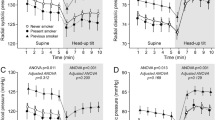Summary
The effects of a single dose of 2 mg/kg amrinone (60 min constant rate IV infusion) have been assessed in a double-blind, placebo-controlled, within-subject cross-over study in six healthy volunteers. Combined impedance cardiography, phonocardiography and electrocardiography revealed a protracted drop in mean ventricular ejection time and electromechanical systole together, with a protracted rise in the “contractility” indices dZ/dtmax and the Heather index HI. The profile is compatible with combined venous vasodilation and positive inotropic action. In spite of the methodological constraints, endpoints were reached that were both detectable and relevant. The profiling permitted a better distinction to be made between the possible levels of action than systolic time intervals alone could have done. Therefore, these methods may be of value in the early development of “inodilator” drugs.
Similar content being viewed by others
References
Marcus FI, Opie LH, Sonnenblick EH (1987) Digitalis and inotropic-dilators. In Drugs for the heart Opie LH (ed) Grune and Stratton, p 101
de Mey C, Enterling D (1986) Assessment of the hemodynamic response to passive head up tilt by non-invasive methods in normal subjects. Meth Find Exptl Clin Pharmacol 8: 449–457
de Mey C, Enterling D (1987) Non-invasive estimates of cardiac performance during and immediately after single and repeated passive upright tilt in normal man: volume dependency of systolic time intervals and maximum velocity of transthoracic impedance changes. Am J Noninvasive Cardiol 1: 188–196
de Mey C, Enterling D, Wesche H, Brendel E (1988) Pharmacokinetic and pharmacodynamic effects of single oral doses of ibopamine, quinidine and their combination in normal man. Eur J Clin Pharmacol 34: 415–418
de Mey C, Hansen-Schmidt S, Enterling D, Meineke I (1989) Time course and nature of postprandial hemodynamic changes in normal man. Clin Physiol 9: 77–87
de Mey C, Enterling D, Meineke I (1989) Pharmacokinetic and pharmacodynamic interactions between single oral doses of ibopamine and food in normal man. Drug Res 39: 1138–1143
Ebert TJ, Smith JJ, Barney JA, Merrill DC, Smith GK (1986) The use of thoracic impedance for determining thoracic blood volume changes in man. Aviat Space Environ Med 57: 49–53
Lababidi Z, Ehmke DA, Durnin RE, Leaverton PE, Lauer RM (1970) The first derivative thoracic impedance cardiogram. Circulation 41: 651–658
Welham KC, Mohapatra SN, Hill DW, Stevenson L (1978) The first derivative of the transthoracic electrical impedance as an index of changes in myocardial contractility in the intact anaesthetised dog. Intens Care Med 4: 43–50
Weissler AM, Harris WS, Schoenfeld CD (1968) Systolic Time Intervals in heart failure in man. Circulation 37: 149–159
Kubicek WG, Karnegis JN, Patterson RP, Witsoe DA, Mattson RH (1966) Development and evaluation of an impedance cardiac output system. Aerosp Med 37: 1208–1212
Geddes LA and Sadler C (1973) The specific resistance of blood at body temperature. Med Biol Eng 5: 336–339
Siegel JH, Fabian M, Lankau C, Levine M, Cole A, Nahmad M (1970) Clinical and experimental use of thoracic impedance plethysmography in quantifying myocardial contractility. Surgery 57: 907–917
Hill DW, Merrifield AJ (1976) Left ventricular ejection and the Heather Index measured by non-invasive methods during postural change in man. Acta Anaesth Scand 20: 313–320
Opie LH (1986) Inodilators. Lancet I: 1336
Tan LB, Murray RG, Littler WA (1987) An analytical method to separate inotropic and vasodilatory drug effects in patients with heart failure. Cardiovasc Res 21: 625–630
Stern HC, Wolf GK, Belz GG (1985) Comparative measurements of left ventricular ejection time by mechano-, echo- and electrical impedance cardiography. Drug Res 35: 1582–1586
de Mey C, Belz GG (1989) Pitfalls and limitations in the usage of impedance cardiography. Br Heart J 61: 128–129
Stern H, Matthews J, Belz G (1984) Influence of dihydralazine induced afterload reduction on systolic time intervals and echocardiography in healthy subjects. Br Heart J 52: 435–439
Nakamura Y, Wiegner AW, Gaasch WH, Bing OHL (1983) Systolic time intervals: assessment by isolated cardiac muscle studies. JACC 2: 973–978
Buch J, Egeblad H, Hansen PB, Kjaergard H, Waldoff S, Steiness E (1980) Correlation between changes in systolic time intervals and left ventricular end-diastolic diameter after preload reduction. Br Heart J 44: 668–671
Cardenas LM, Vidaurri DA (1979) Estudio de los efectos hemodynamicos de differentes dosis de un nuevo inotropico: la amrinona. Arch Inst Cardiol Mex 49: 961–968
Hermiller JB, Leithe ME, Magorien RD, Unverferth DV, Leier CV (1984) Amrinone in severe congestive heart failure: another look at an intriguing new cardioactive drug. J Pharmacol Exp Ther 228: 319–326
Wilmshurst PT, Thompson DS, Jenkins BS, Coltart DJ, Webb-Pepole MM (1983) Hemodynamic effects of intravenous amrinone in patients with impaired left ventricular function. Br Heart J 49: 77–82
Wilmshurst PT, Thompson DS, Jull SM, Jenkins BS, Coltart DJ, Webb-Peploe MM (1984) Comparison of the effect of amrinone and sodium nitroprusside on hemodynamics, contractility and myocardial metabolism in patients with cardiac failure due to coronary artery disease and dilated cardiomyopathy. Br Heart J 52: 38–48
Benotti JR, Grossman, Braunwald E, Davolos DD, Alousi AA (1978) Hemodynamic assessment of amrinone. N Engl J Med 299: 1373–1377
Firth BG, Rather AV, Grassman ED, Winnford MD, Nicod P, Hillis LD (1984) Assessment of the inotropic and vasodilator effects of amrinone versus isoproterenol. Am J Cardiol 54: 1331–1336
Thormann J, Kramer W, Kindler M, Kremer P and Schlepper M (1987) Bestimmung der Wirkkomponenten von Amrinon durch kontinuierliche Analyse der Druck-Volumen-Beziehungen; Anwendung der Conductance-(Volumen-)Kathetertechnik und der schnellen Laständerung durch Ballonokklusion der Vena Cava inferior. Z Kardiol 76: 530–540
Author information
Authors and Affiliations
Rights and permissions
About this article
Cite this article
de Mey, C., Enterling, D. & Hanft, G. Noninvasive assessment of the inodilator action of amrinone in healthy man. Eur J Clin Pharmacol 40, 373–378 (1991). https://doi.org/10.1007/BF00265846
Received:
Accepted:
Issue Date:
DOI: https://doi.org/10.1007/BF00265846




